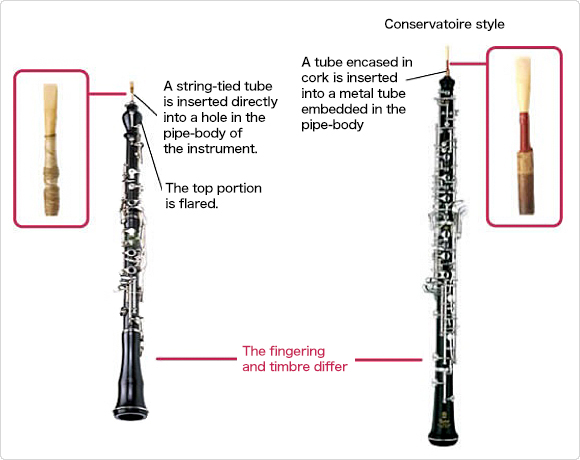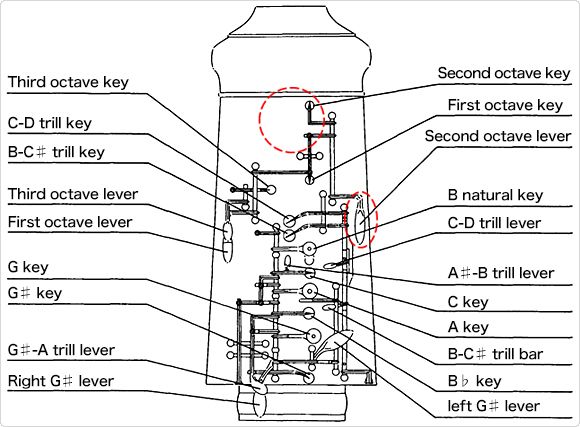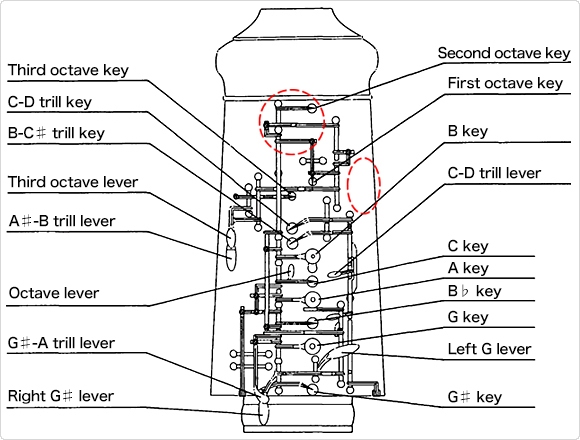Choosing an Oboe
What are the key points when selecting an oboe?
German style or French style
There are two styles of oboe: German and French.
The German style was mainstream in the 19th century, but nowadays it is a special oboe used only by Viennese performers, such as those with the Vienna Philharmonic. For that reason, this style is called the Wiener oboe. Such instruments are characterized by their somewhat nasal-sounding, bright and rich tones. They are a direct development of the three-keyed Baroque oboe of the 18th century. The fingering somewhat resembles that of a recorder.
Currently, the French-style mechanism for the oboe is mainstream. The French style was developed in the 19th century and was then adopted by the Conservatoire du Paris, thus becoming known as the Conservatoire style. This style became widespread because its key system, which allows high-volume, fast songs to be played, matches what is needed today, to the point that the Wiener oboe could be called a specialized instrument nowardays.
For beginners, it is typical to start with the Conservatoire style, even for players who have a preference for the Viennese timbre.
A Wiener oboe (left) and a Conservatoire-style oboe (right)

Semi-automatic or fully-automatic
There are both semi- and fully-automatic systems for the oboe, which differ based on the operating of the octave keys. Both systems have their strengths and weaknesses. Although which to choose is ultimately up to the player's preference, the semi-automatic system is recommended for beginners.
| System name | Characteristics |
|---|---|
| Semi-automatic system | The player must manipulate the first and second octave keys, but there is a high degree of flexibility in terms of fingering, and this system is widely used around the world. |
| Fully-automatic system | There is no second octave lever, and manipulation is simple, but, because the structure is complicated, adjustment is difficult and players are prone to going off-key. The heft also makes it seem that the player is blowing harder. |
Semi-automatic system

Fully-automatic system

Grenadilla or rosewood
People tend to picture oboes as black tubes. The material used to make black oboes is a wood called grenadilla, which is also used in clarinets. Oboes made from grenadilla-which is characterized by the heft it has due to its relative density of between 1.2 and 1.3-have the advantage of their sound projecting far. This would seem to make them suited to large concert halls.
Rosewood, a brown-colored type of lumber, is also used to make oboe pipes. Rosewood produces a softer sound that harmonizes well with other wind instruments and with string instruments. The sound does not project as well as that produced with grenadilla, but the tones are very distinct. Instruments made from this material would seem suited for chamber music.

An oboe made from king rosewood
Musical Instrument Guide:Oboe Contents
Structure
How to Play
How the Instrument is Made
Choosing an Instrument
Trivia
- Why does the oboe lead the orchestra in tuning?
- Do the reeds have a front and a back?
- The keys recoil via springs!
- This is how the oboe and the cor anglais differ
- The charumera was the oboe's cousin
- You can reduce time spent breathing using circular-breathing techniques?
- The Wiener oboe that survived an existential crisis
- Oboe masterpieces: concertos
- Oboe masterpieces: chamber music
- What is the alto oboe?
- The heckelphone, which resembles the oboe
- The oboe is the bassoon's cousin
